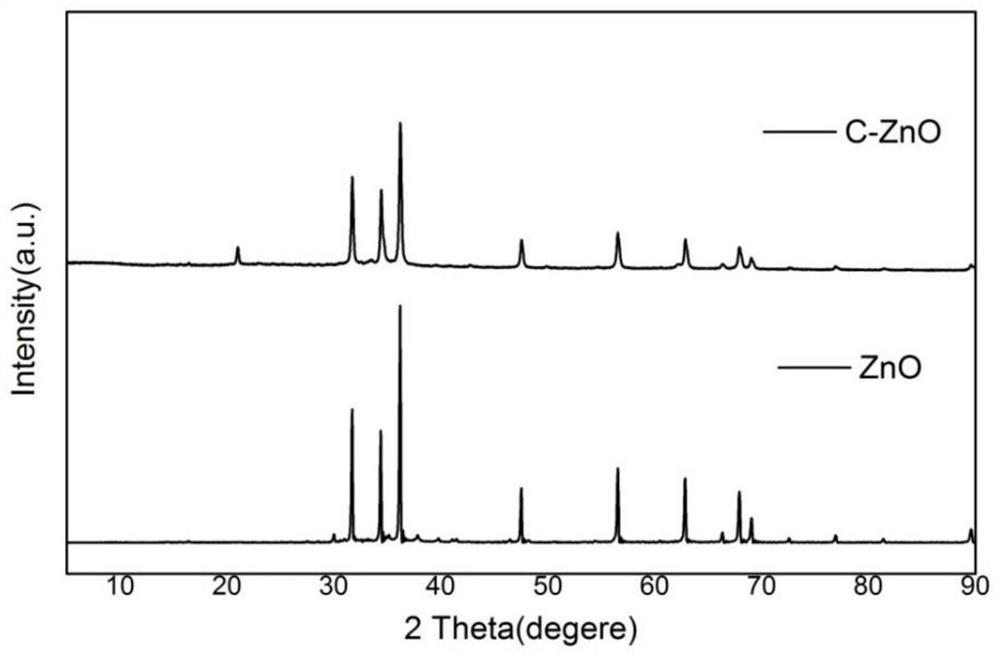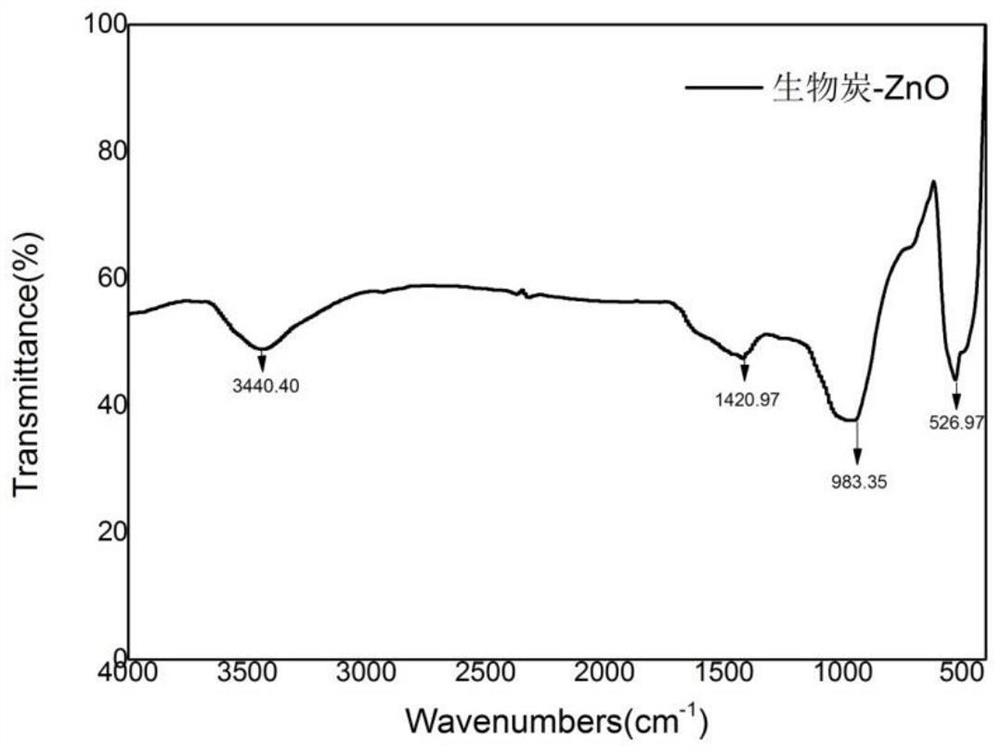Catalyst for pollutant degradation under natural light and preparation method of catalyst
A natural light and catalyst technology, applied in physical/chemical process catalysts, water pollutants, chemical instruments and methods, etc., can solve the problems of human and environmental damage, cumbersome preparation process, secondary pollution of by-products, etc., and reduce production costs. , Large specific surface area, the effect of improving efficiency
- Summary
- Abstract
- Description
- Claims
- Application Information
AI Technical Summary
Problems solved by technology
Method used
Image
Examples
Embodiment 1
[0043] Add 1g of Spartina alterniflora to 200ml of ethanol, incubate at 70°C for 2 hours, and filter to prepare Spartina alterniflora filtrate;
[0044] Take 10ml of Spartina alterniflora filtrate, add 5.6g of zinc acetate, 1.8g of sodium hydroxide, 0.2g of Spartina alterniflora powder, stir, and sonicate for 2 hours to obtain 20ml of loaded biochar-ZnO nanoparticle precursor;
[0045] React the biochar-ZnO nanoparticle precursor prepared above in a 70°C water bath for 5 hours to prepare 18ml of biochar-ZnO nanoparticle precursor carbon airgel;
[0046] The above-mentioned loaded biochar-ZnO nanoparticle precursor carbon airgel was centrifuged at 8000r / min for 2min, and dried at 60°C to obtain 3.2g of the dried loaded biochar-ZnO nanoparticle precursor carbon airgel;
[0047] The dried loaded biochar-ZnO nanoparticle precursor carbon aerogel was calcined at 900 °C in anaerobic high temperature to obtain 2.4 g of biochar-ZnO nanoparticle composite catalyst.
[0048] X-ray diff...
Embodiment 2
[0056] Add 1g of Spartina alterniflora to 200ml of ethanol, incubate at 70°C for 2 hours, and filter to prepare Spartina alterniflora filtrate;
[0057] Take 10ml of Spartina alterniflora filtrate, add 5.6g of zinc acetate, 1.8g of sodium hydroxide, 2.8g of Spartina alterniflora powder, stir, and sonicate for 2 hours to obtain 21.3ml of biochar-ZnO nanoparticle precursor;
[0058] React the loaded biochar-ZnO nanoparticle precursor prepared above in a 70°C water bath for 5 hours to prepare 19.1ml of loaded biochar-ZnO nanoparticle precursor carbon airgel liquid;
[0059] Prepare the above-mentioned loaded biochar-ZnO nanoparticle precursor carbon airgel, centrifuge at 8000r / min for 2min, and dry at 60°C to obtain 3.61g of loaded biochar-ZnO nanoparticle precursor carbon airgel after drying;
[0060] The dried loaded biochar-ZnO nanoparticles precursor carbon aerogel was calcined at 900 °C in anaerobic high temperature to obtain 3.13 g of biochar-ZnO nanoparticles composite cat...
Embodiment 3
[0063] Add 1g of Spartina alterniflora to 200ml of ethanol, incubate at 70°C for 2 hours, and filter to prepare Spartina alterniflora filtrate;
[0064] Take 10ml of Spartina alterniflora filtrate, add 5.6g of zinc acetate, 1.8g of sodium hydroxide, 2g of Spartina alterniflora powder, stir, and sonicate for 2 hours to obtain 20.8ml of biochar-ZnO nanoparticle precursor;
[0065] React the loaded biochar-ZnO nanoparticle precursor prepared above in a 70°C water bath for 5 hours to prepare 18.5ml of loaded biochar-ZnO nanoparticle precursor carbon airgel;
[0066] The above-mentioned loaded biochar-ZnO nanoparticle precursor was centrifuged at 7000r / min for 3min, and dried at 80°C to obtain 3.42g of the dried loaded biochar-ZnO nanoparticle precursor carbon airgel;
[0067] The dried loaded biochar-ZnO nanoparticle precursor carbon aerogel was calcined at 900 °C in anaerobic high temperature to obtain 3.02 g of biochar-ZnO nanoparticle composite catalyst.
PUM
 Login to View More
Login to View More Abstract
Description
Claims
Application Information
 Login to View More
Login to View More - R&D
- Intellectual Property
- Life Sciences
- Materials
- Tech Scout
- Unparalleled Data Quality
- Higher Quality Content
- 60% Fewer Hallucinations
Browse by: Latest US Patents, China's latest patents, Technical Efficacy Thesaurus, Application Domain, Technology Topic, Popular Technical Reports.
© 2025 PatSnap. All rights reserved.Legal|Privacy policy|Modern Slavery Act Transparency Statement|Sitemap|About US| Contact US: help@patsnap.com


